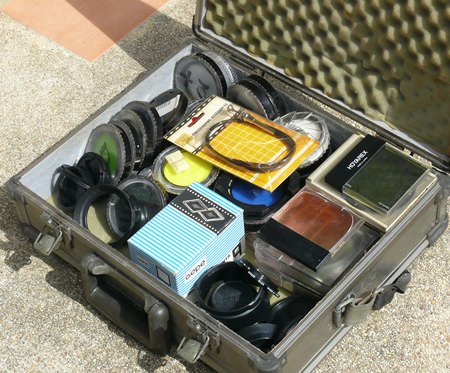I have to admit I stumbled across an alloy box the other day, which I hadn’t seen (or missed) for many years. It was one of those items you lug all over the world because, at one time, the contents were important, or were thought to be.
It was like opening Pandora’s box after I blew the dust and cobwebs off it. There were about 20 filters, adapters, special effects equipment and even a box of slides for 6 x 6 cm slides. Many of the filters were of the type that pro photographers keep for when a specific image is required. That covered items such as Neutral Density (ND) filters, magnifying filters and even a ‘Speed’ filter (to give the illusion of traveling fast), nothing to do with methamphetamine! There were also colored filters for use with Black and White film, museum pieces really!

So it is obvious that these filters were certainly not needed on a daily basis. So why have them at all? As mentioned above, some are for specific images, but many are just items you accumulate as you learn what photography and image manipulation is all about. A well spent training course, in my opinion.
However, before rushing out to get filters, you do need to standardize your equipment. The first thing I did when I unpacked my new camera was to check the size of the lens diameter. It was 55 mm. The second thing I did was to rake through my collection of stepping rings to screw on to the end of the lens to bring the diameter up to 62 mm.
The first reason was to make the new camera lens compatible with my box of photographic filters. The vast majority of these are 62 mm, which is a good size as it is larger than most 35 mm camera lenses, so will not produce a vignetting effect if you stack a few of them together, such as a polarizer and a +1 magnifier.
So here’s what I think you should have. The first one is called simply a Skylight 1A. This filter does make the sky a little deeper, but the main reason to have it is as a sacrificial piece of glass, so that your good, expensive lens does not get scratched. Skylight 1A’s are very cheap.
One of the nicest filter effects is what is called “center spot soft focus”. Now this just means the center is in focus and the edges are nicely soft and blurred. This effect is used by portrait and wedding photographers all over the world to produce that wonderful “romantic” photograph.
You can also use these filters with any compact point and shoot camera, but it is a little more hit and miss, as there’s no WYSIWYG with compacts. What you have to do is position the center of the filter over the lens and, while keeping it there, bring the camera up to your eye, compose the shot and then shoot. Takes some fiddling and manual dexterity and take a few shots as you are really flying blind.
The next one is the polarizer. I have mentioned polarizers before, but the difference between polarized sunlit shots and unpolarized is incredible. The depth of color when you polarize is fantastic. As you rotate the polarizing filter, the reflections on any shiny surface, be that grass, trees, water or whatever, just disappear, leaving the undiluted bold color.
Soft romantic effects can be produced by gently breathing on the Skylight 1A filter just before you take the shot. Your warm breath will impart a “mist” to produce a wonderfully misty portrait, or that early morning mist look for landscapes. Remember that the “misting” only lasts a few seconds, so make sure you have the camera pre-focussed and ready to shoot.
Another interesting result is by smearing Vaseline on the same Skylight 1A and seeing the different effects you get. Do not smear the Vaseline on the end of your lens. It is impossible to get off without washing in hot soapy water, something you can do with a filter, but not with your lens.
I will go through my Pandora’s box next week and have some fun.




